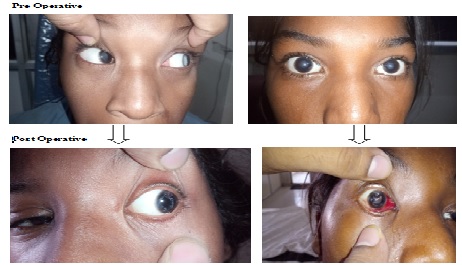Congenital cataract- a riddle to be solved to prevent childhood blindness
Abstract
Introduction: Congenital cataract is a significant cause of visual disability in developing countries. It may present at birth or develop within first year of life. Common causes are genetic disorders, intra uterine infections, drug induced and others. Hence management protocol depends from case to case. Timely management of cataract and rehabilitation significantly prevents visual morbidity in children.
Aims and Objectives: To asses visual outcomes in congenital cataract.
Material and Methods: A prospective study was done from January 2017 to July 2018, including 40 patients with age ranging from 1 month to 12 years. Detailed history and thorough examination of each patient was done. After fulfilling inclusion criteria we have planned them for small incision cataract surgery (SICS) and phacoemulsification as per the financial status of family. Only cases less than 1 year were left aphakic. IOL power was calculated using SRK-II formula. Post operative visual acuity was noted on 7th day, 15th day and 1 month. Visual rehabilitation in the form of amblyopia therapy, secondary IOL and contact lenses was given.
Result: It was found that squint (20%) and amblyopia (17.5%) was associated with cataract. All 40 eyes underwent cataract extraction by phacoemulsification (60%) and SICS (40%). Among them 25% cases were left aphakic. Visual improvement was almost similar in both surgeries. Visual rehabilitation in the form of spectacles (45%), contact lenses (5%), occlusion therapy (17.5%) and secondary IOL (22.5%) were given.
Conclusion: Proper counseling of parents at diagnosis helps in prompt management and improves compliance which significantly reduces visual morbidity in children.
Downloads
References
2. Gibbs ML, Jacobs M, Wilkie AO, et al. Posterior lenticonus: clinical patterns and genetics.J Pediatr Ophthalmol Strabismus. 1993 May-Jun;30(3):171-5.[pubmed]
3. Francis PJ, Moore AT. Genetics of childhood cataract. Curr Opin Ophthalmol. 2004 Feb;15(1):10-5.[pubmed]
4. Lin H, Yang Y, Chen J, et al. Congenital cataract: prevalence and surgery age at Zhongshan Ophthalmic Center (ZOC). PLoS One. 2014;9:e101781.
5. Drummond GT, Scott WE, Keech RV. Management of monocular congenital cataracts. Arch Ophthalmol. 1989 Jan;107(1):45-51.[pubmed]
6. Birch EE, Stager DR. The critical period for surgical treatment of dense congenital unilateral cataract. Invest Ophthalmol Vis Sci. 1996 Jul;37(8):1532-8.[pubmed]
7. Lundvall A, Kugelberg U. Outcome after treatment of congenital unilateral cataract. Acta Ophthalmol Scand. 2002 Dec;80(6):588-92.[pubmed]
8. World Health Organization Preventing Blindness in Children; 2000.[pubmed]
9. Birch EE, Wang J, Felius J, Stager Jr DR, Hertle RW. Fixation control and eye alignment in children treated for dense congenital or developmental cataracts. J AAPOS. 2012;16:156e160
10. Elston JS, Timms C. Clinical evidence for the onset of the sensitive period in infancy. Br J Ophthalmol. 1992 Jun;76(6):327-8.[pubmed]
11. Birch EE, Cheng C, Stager DR Jr, et al. The critical period for surgical treatment of dense congenital bilateral cataracts. J AAPOS. 2009 Feb;13(1):67-71. doi: 10.1016/j.jaapos.2008.07.010. Epub 2008 Dec 12.
12. Chak M, Wade A, Rahi JS; et al. Long-term visual acuity and its predictors after surgery for congenital cataract: findings of the British congenital cataract study. Invest Ophthalmol Vis Sci. 2006 Oct;47(10):4262-9. DOI:10.1167/iovs.05-1160.[pubmed]
13. Jain S, Ashworth J, Biswas S, et al. Duration of form deprivation and visual outcome in infants with bilateral congenital cataracts. J AAPOS. 2010 Feb;14(1):31-4. doi: 10.1016/j.jaapos.2009.11.016.[pubmed]
14. Eriksen JR, Bronsard A, Mosha M, Carmichael D, Hall A, Courtright P. Predictors of poor follow-up in children that had cataract surgery. Ophthalmic Epidemiol. 2006;13:237e243.[pubmed]
15. Tomkins O, Ben-Zion I, Moore DB, et al. Outcomes of pediatric cataract surgery at a tertiary care center in rural southern Ethiopia. Arch Ophthalmol. 2011 Oct;129(10):1293-7 doi:10.1001/archophthalmol.2011.268.[pubmed]
16. Abdelmoaty SM, Behbehani AH. The outcome of congenital cataract surgery in Kuwait. Saudi J Ophthalmol. 2011 Jul;25(3):295-9. doi: 10.1016/j.sjopt.2011.01.002. Epub 2011 Jan 14.[pubmed]
17. Khandekar R1, Sudhan A, Jain BK, et al. Pediatric cataract and surgery outcomes in Central India: a hospital based study. Indian J Med Sci. 2007 Jan;61(1):15-22.[pubmed]
18. Eriksen JR, Bronsard A, Mosha M, Carmichael D, Hall A, Courtright P. Predictors of poor follow-up in children that had cataract surgery. Ophthalmic Epidemiol 2006;13:237-43.[pubmed]
19. Thakur J, Reddy H, Wilson ME Jr, et al. Pediatric cataract surgery in Nepal. J Cataract Refract Surg. 2004 Aug;30(8):1629-35. DOI:10.1016/j.jcrs.2003.12.047.[pubmed]
20. Lee YC, Kim HS. Clinical symptoms and visual outcome in patients with presumed congenital cataract. J Pediatr Ophthalmol Strabismus. 2000;37:219e224.
21. Msamati BC, Igbigbi PS, Batumba NH. Prevalence of lens opacity at Queen Elizabeth Central Hospital in Blantyre, Malawi. East Afr Med J. 2000 Nov;77(11):583-7.[pubmed]
22. Birch EE, Stager DR. The critical period for surgical treatment of dense congenital unilateral cataract. Invest Ophthalmol Vis Sci. 1996 Jul;37(8):1532-8.[pubmed]
23. Sjoestrand J, Magnusson G, Nystroem A, Jonsson R. Stability of visual outcome from 7 years in children treated surgically for bilateral dense congenital cataracts before 37 weeks of age. Acta Ophthalmol (Copenh) 2011;89(1):30–6.
24. Birch EE, Wang J, Felius J, et al. Fixation control and eye alignment in children treated for dense congenital or developmental cataracts. J AAPOS. 2012 Apr;16(2):156-60. doi: 10.1016/j.jaapos.2011.11.007.[pubmed]
25. Jitendra Kumar, Aakanksha Gehra, Shubhanshu Gupta. Outcomes of Visual Acuity after Paediatric Cataract Surgery at Medical College in Jhansi, (U.P) IOSR Journal of Dental and Medical Sciences (IOSR-JDMS) Volume 15, Issue 5 Ver. IX (May. 2016), PP 54-58.

Copyright (c) 2019 Author (s). Published by Siddharth Health Research and Social Welfare Society

This work is licensed under a Creative Commons Attribution 4.0 International License.


 OAI - Open Archives Initiative
OAI - Open Archives Initiative



















 Therapoid
Therapoid

